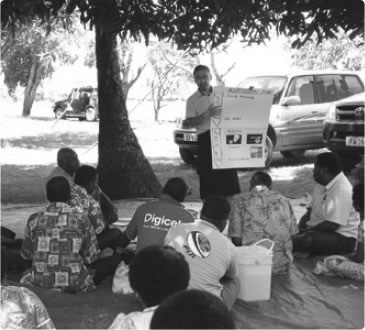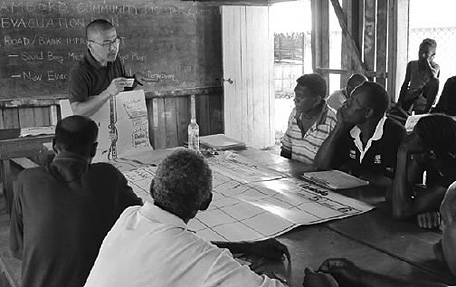Japan's Official Development Assistance White Paper 2011
Column 6
Incorporating Lessons from the Great East Japan Earthquake
—The Strengthening Community-Based Disaster Risk Management Project in the Pacific Region—

Workshop in Fiji (Photo: Megumi Matsuoka)
Fiji is composed of over 300 islands lying about 3,000 kilometers east of Australia in the Pacific Ocean. Every year, the nation suffers from flooding caused by torrential rains brought on by cyclones. Solomon Islands, also situated in the Pacific Ocean, comprise six main islands and some 1,000 smaller islands. Because more than 90% of its population lives in coastal areas or near the mouth of rivers, the people are vulnerable to disasters from tsunami, high tides, and flooding. At the request of the governments of Fiji and the Solomon Islands, Japan launched in October 2010 the three-year Strengthening Community-based Disaster Risk Management Project in the Pacific Region, in the interest of not wasting its experiences in natural disasters but putting them to use in parts of the world that need a helping hand. Masaaki Kanaya is an expert actively involved in this project, guiding communities in disaster prevention and evacuation planning and drills.
Mr. Kanaya says of his ambitions: "The most important thing is to raise awareness of disaster prevention at the community level. I hope that by learning the mechanism that causes flooding, and improving understanding about risk reduction and evacuation preparedness, each resident will foster a 'spirit of self-help' that goes hand-in-hand with nature."
As a part of his activities, Mr. Kanaya held a flood risk recognition workshop at an elementary and middle school in the Solomon Islands' village of Tamboko on February 25, 2011. Only three days before, there was an accident in the village: a student drowned in the river and died. Two students had jumped into the river and were playing, until they bumped into each other. One managed to crawl up on shore, but the other, unconscious, drifted in the stream and was found dead several hours later. The crash happened because the swollen river had turned a cloudy brown and blocked the students' view of one another. Tamboko custom sets a mourning period of ten days after accidents like this, and held that no events take place during this time. The workshop, needless to say, was cancelled. Mr. Kanaya, who arrived the day after the accident for a meeting, discussed the matter with the village head, who after careful consideration, decided to hold the workshop as planned: "In the wake of this tragic accident, I would like the entire village to reassess the dangers of river floods." The following week, Mr. Kanaya even walked the riverside paths with the residents, including the students, explaining to them the dangers of flooding waters and confirming with them the hazard areas. This was later featured on the front page of a local newspaper. The residents who read the article vowed never to forget their recent experience and to prevent a similar accident from ever happening again.
Japan's experiences in the Great East Japan Earthquake are also playing a part in the project.
In the March 11 tsunami that swallowed eastern Japan, it is reported that residents were aware neither of the proper use of hazard maps nor of accurate information as to evacuation procedures and shelters. Learning from this lesson, the project in Fiji and the Solomon Islands decided to make detailed entries on a base map of high ground, low ground, important facilities, and riverside areas inclined to collapse. The residents are involved in this task, so that they can reconfirm the conditions of their communities. The project is also confirming the safe evacuation sites near each community and creating evacuation plans suited to the actual conditions of each site.
Mr. Kanaya repeatedly tells the people of both countries that measures for structures like equipment and facilities alone do not ensure safety, and that he wants them to think about protecting their own safety. He says, "I consider it my mission to communicate the 'spirit of self-help' to as many people as possible in countries prone to the risk of natural disasters."

Explaining the evacuation plan in Tamboko (Mr. Kanaya at center) (Photo: Takashi Oba)
